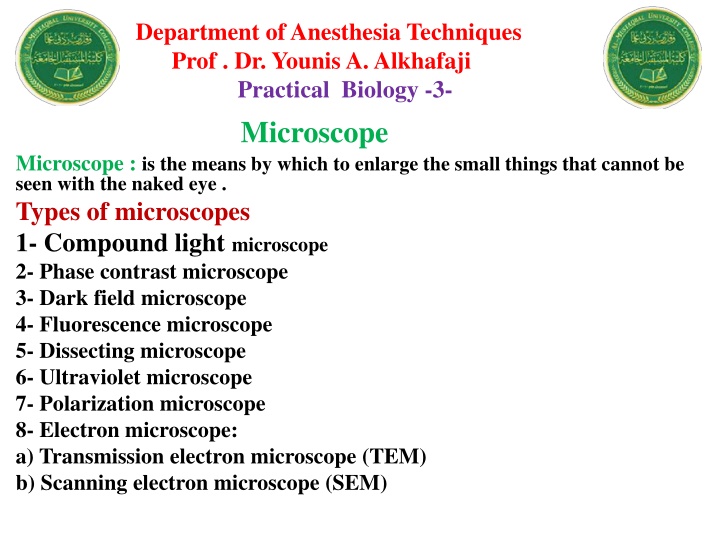
Microscope Types and Parts Explained
Discover the various types of microscopes and their functions, including compound light microscopes, phase contrast microscopes, and electron microscopes. Learn about the different parts of a microscope such as eyepiece, objectives, stage, and condenser. Find out essential care tips to maintain your microscope for optimal performance.
Download Presentation

Please find below an Image/Link to download the presentation.
The content on the website is provided AS IS for your information and personal use only. It may not be sold, licensed, or shared on other websites without obtaining consent from the author. If you encounter any issues during the download, it is possible that the publisher has removed the file from their server.
You are allowed to download the files provided on this website for personal or commercial use, subject to the condition that they are used lawfully. All files are the property of their respective owners.
The content on the website is provided AS IS for your information and personal use only. It may not be sold, licensed, or shared on other websites without obtaining consent from the author.
E N D
Presentation Transcript
Department of Anesthesia Techniques Prof . Dr. Younis A. Alkhafaji Practical Biology -3- Microscope Microscope : is the means by which to enlarge the small things that cannot be seen with the naked eye . Types of microscopes 1- Compound light microscope 2- Phase contrast microscope 3- Dark field microscope 4- Fluorescence microscope 5- Dissecting microscope 6- Ultraviolet microscope 7- Polarization microscope 8- Electron microscope: a) Transmission electron microscope (TEM) b) Scanning electron microscope (SEM)
The Optical (light) Microscope Light Microscope: Parts & Function 1-Eypiece(Ocular lenses): It one or two lenses use to look through the microscope and it has 5 or 20 times of the magnification but X10 it generally used. 2-Optical tube: It connect the eye piece with objective lenses. Standard length 16 cm 3- Revolving Nose piece : It hold four objectives lenses .It can be rotation left and right to change magnification power. 4- Objectives lenses: It four lenses on the Revolving Nosepiece.it has differs with length and magnification power. Then the shorter one it the lower mag. a-Low power(L.P) :It magnify about 4 times(X4) b-Low power ( L.P) :It magnify about 10 time(X10) c-High power objective (H.P):It magnify about 40 times (X40) d-Oil immersion objective: It magnify about 100 time(X100)and use special oil on the slide.
5- specimen Stage :It hold the specimen . 6- Clips: it used for slide fixing on the stage 7-Condencer: It located under the stage and can moved it up and down to adjust the light band on the object(sample). 8-Iris Diaphragm : It used for regulation the illumination of the object(sample) to examined. 9-Illumination: (Tungsten-halogen light bulb) for all microscope types except (u.v or carbon) for Fluorescent microscope. 10-Coarse adjustment knob: Used for stage movement up and down to adjust the distance between objectives lenses and the slide. 11-Fine adjustment knob: Used for clarity of the vision . 12-Arm: Used for microscope hold 13- Foot Base: Used for standing and supporting of the microscope.
Microscope care 1. Always carry with two hands one holding the arm and the other hold the base of instrument. 2. Only use lenses paper for cleaning 3. Do not force the knobs and Focus smoothly; don't try to speed through the focusing process or force anything. 4. Always make sure the stage and lenses are clean before putting away the microscope. 5. Always store covered. 6. Turn the instrument off when it is not in use.

















